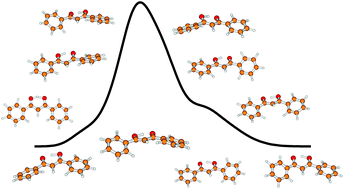The UVA response of enolic dibenzoylmethane: beyond the static approach†
Abstract
Enolic dibenzoylmethane is used in cosmetic sunscreens as a UVA filter because it strongly absorbs radiation around 340 nm. Assessing the absorption properties solely on the basis of the vertical excitation spectrum at the minimum of the potential energy surface leads to the conclusion that the nπ* state is not initially photoexcited. Since this molecule exhibits large changes in structure due to nuclear thermal and quantum fluctuations, it is not sufficient to consider one molecular configuration but an ensemble of configurations. In this work, we simulate its UVA response by employing the DFT/MRCI method in conjunction with configurations sampled from density functional theory-based classical and path integral molecular dynamics as well as by computing Franck–Condon factors. Our findings indicate that thermal and nuclear quantum fluctuations symmetrically broaden the excited states’ absorption within the semi-classical approximation and thus it is necessary to include vibronic effects in order to correctly reproduce the experimental spectrum. The absorption is largely dominated by the ππ* state but there is a minor contribution from the nπ* state, contrary to the static result. The crossing between these two states occurs during the intramolecular proton transfer. This knowledge is of importance for studying photorelaxation mechanisms of dibenzoylmethane and other β-diketone compounds.



 Please wait while we load your content...
Please wait while we load your content...